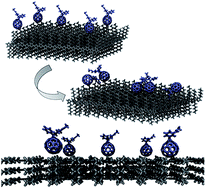Correlating fullerene diffusion with the polythiophene morphology: molecular dynamics simulations†
Abstract
Polymer film morphology is known to correlate with the efficient charge transport and device efficiency of the bulk heterojunction solar cell. Further improvements of the performance of organic solar cells require a better understanding of the mechanisms of diffusion and molecular rearrangement. In this paper, we used atomistic molecular dynamics simulations to provide insights into the factors affecting diffusion of [6,6]-phenyl-C61-butyric acid methyl ester (PCBM) and fullerene (C60) into poly(3-hexylthiophene) (P3HT). We examined the diffusion and interactions of PCBMs in amorphous and around crystalline P3HTs at different temperatures. Simulations showed that fullerene particles tend to aggregate in amorphous P3HTs and on (100) surfaces. However, the diffusion of fullerenes on the (010) surface was mainly attributed to the preferential binding between fullerene cages and aromatic P3HT backbone which led to their directional diffusion on the thiophene backbone. The presence of the functional group in PCBM can be attributed to an increase in the diffusion coefficient by a factor of 1.5 to 2 as compared to C60. Interestingly low regioregularity of P3HTs reduced the diffusion and aggregation of PCBMs.


 Please wait while we load your content...
Please wait while we load your content...